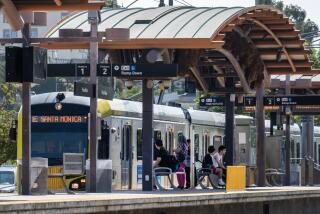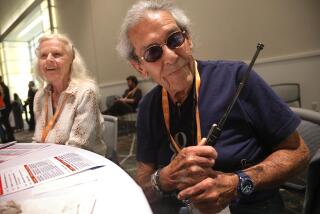Use of public transportation jumps
- Share via
When Sheyenne Reyes was growing up in Riverside she could always find a seat on the public bus.
Reyes is 21 now, and while waiting for the Route 1 line to take her to work last week, the college student lamented that these days the bus often “gets too crowded to the point where some people have to stand up — they stumble a little bit” as the bus rushes from one stop to another.
Standing nearby with his wife and infant daughter, 24-year-old Trayvor Chandlis said that he’s looking for work and that his family rides the bus because of high gas prices. But, he said, there’s not always a place to sit and sometimes the rides are especially time-consuming.
“It’s cheaper to do it, it just takes too ... long,” said Chandlis, who said he’d come to Riverside from Hemet to see a pediatrician. But “you gotta do it. You gotta get from place to place.”
Ridership across the Riverside Transit Agency has jumped 27% in the last decade, from 7.1 million trips in 2002 to a projected 9 million this year, officials said.
Riverside County is not alone: More people nationwide are using public transit, according to a report released Monday by the American Public Transportation Assn., a group that advocates for the transit industry.
Nationally, trips on public buses and trains rose 2.6% in the first three quarters of 2012 compared with the same period last year, totaling more than 7.9 billion, according to the report.
Students like Reyes and struggling families such as the Chandlises are a big reason for the jump.
“What’s driving a lot of this is these gas prices are just so high. We’re a relatively high-unemployment area, so it’s pretty tough for a lot of folks, and riding a bus is a good alternative,” said Riverside County Supervisor Marion Ashley, who is also an RTA official. Also, “we’re getting all these students.”
For the Los Angeles County Metropolitan Transportation Authority, the gains were more modest. The system’s ridership rose 1.7% in the first three quarters of 2012, with the number of light rail trips growing 13.7% and bus rides growing only 0.1%, according to the report.
L.A. County Metro officials offer another perspective, however, noting that in October, their system’s rail ridership was up 23% compared with the same month last year, and bus ridership was up 5%. Overall, ridership on the system’s buses and trains was up about 9% in October, at 42.7 million trips compared with 39.2 million in October 2011, according to Metro’s website.
Nationwide, “with seven consecutive quarters of ridership increases, it’s obvious that public demand for public transit is growing,” said Michael Melaniphy, chief executive and president of the American Public Transportation Assn.
“We continue to see that in areas where the local economy is improving and new jobs are being added, public transportation ridership is up,” he said.
In Riverside, officials point to a special fare program for students as one move that has boosted ridership. Such students made up about 15% of overall ridership in the agency’s last fiscal year, totaling more than 1.3 million of the 8.8 million trips taken.
Under the program, students can pay a small fee each semester and use their college identification cards to ride as much as they want at no additional charge. It started in 2006 and now covers six schools: UC Riverside, Riverside City College, Mt. San Jacinto College, Moreno Valley College, California Baptist University and La Sierra University.
Joseph Clark, 19, lives in the Canyon Crest neighborhood and takes the bus to his classes at Riverside City College. Because of the student fare program, he said, he didn’t bother his parents for money for a car.
“I didn’t use public transit until I started college because getting a car is so expensive,” Clark said while waiting for a bus. “Either I make my parents pay an extra $1,100 for a car or $10 for transit — it’s common sense.”
If the program weren’t in place, Clark said, he wouldn’t think twice about trying to get a new set of wheels.
“I’m saving up for a car,” he said. Taking the bus is “kind of something that I have to do right now. If I had the choice, I probably wouldn’t.”
More to Read
Sign up for Essential California
The most important California stories and recommendations in your inbox every morning.
You may occasionally receive promotional content from the Los Angeles Times.










